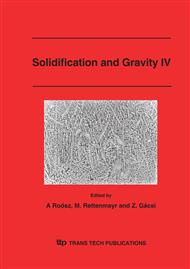[1]
H. Yu, D. A. Granger, Macrosegregation in aluminum alloy ingot cast by the semicontinuous direct chill (DC) method, Aluminum Alloys: Their Physical and Mechanical Properties, EMAS, UK, 1986, pp.17-29.
DOI: 10.1002/9781118647783.ch102
Google Scholar
[2]
C. J. Vreeman, F. P. Incropera, The effect of free-floating dendrites and convection on macrosegregation in direct chill cast aluminum alloys, part II: Predictions for Al-Cu and Al-Mg alloys, Int. J. Heat Mass Transfer, Vol. 43 (2000), pp.687-704.
DOI: 10.1016/s0017-9310(99)00175-1
Google Scholar
[3]
C. J. Vreeman, M. J. M. Krane, J. D. Schloz, Direct chill casting of aluminum alloys: Modeling and experiments on industrial scale ingots, J. Heat Transfer ASME, Vol. 124 (2002), pp.947-953.
DOI: 10.1115/1.1482089
Google Scholar
[4]
S. C. Flood, L. Katgerman, V. R. Voller: The calculation of macrosegregation and heat and fluid flows in the DC casting of aluminum alloys, M. Rappaz, M. R. Ozgu, K. W. Mahin (eds), Modeling of Casting, Welding and Advanced Solidification Processes V, TMS, 1991, pp.683-690.
Google Scholar
[5]
A. V. Reddy, C. Beckermann, Modeling of macrosegregation due to thermosolutal convection and contraction driven flow in direct chill continuous casting of an Al-Cu round ingot, Metall. Mater. Trans. B, Vol. 28B (1997), pp.479-489.
DOI: 10.1007/s11663-997-0115-2
Google Scholar
[6]
H. J. Thevik, A. Mo, T. Rusten, A mathematical model for surface segregation in aluminum direct chill casting, Metall. Mater. Trans. B, Vol. 30B (1999), pp.135-142.
DOI: 10.1007/s11663-999-0013-x
Google Scholar
[7]
C. J. Vreeman, F. P. Incropera, Numerical discretization of species equation source terms in binary mixture models of solidification and their impact on macrosegregation in semicontinuous, direct chill casting systems, Numer. Heat Transfer B, Vol. 36 (1999), pp.1-14.
DOI: 10.1080/104077999275749
Google Scholar
[8]
N. Ahmad, H. Combeau, J.-L. Desbiolles, T. Jalanti, G. Lesoult, J. Rappaz, M. Rappaz, C. Stomp, Numerical simulation of segregation: a comparison between finite volume method and finite element method predictions and a confrontation with experiments, Metall. Mater. Trans. A, Vol. 29A (1998), pp.617-630.
DOI: 10.1007/s11661-998-0143-9
Google Scholar
[9]
C. Beckermann, Modeling of macrosegregation: Applications and future needs, Int. Mater. Rev., Vol. 47 (2002), pp.243-261.
Google Scholar
[10]
B. C. H. Venneker, L. Katgerman, Modelling issues in macrosegregation predictions in direct chill castings, J. Light Metals, Vol. 2 (2002), pp.149-159.
DOI: 10.1016/s1471-5317(02)00041-x
Google Scholar
[11]
W. D. Bennon, F. P. Incropera, A continuum model for momentum, heat and species transport in binary solid-liquid phase change systems - I. model formulation, Int. J. Heat Mass Transfer, Vol. 30 (1987), pp.2161-2170.8
DOI: 10.1016/0017-9310(87)90094-9
Google Scholar
[12]
B. P. Leonard, S. Mokhtari, Beyond 1st-Order Upwinding - The ULTRA-SHARP Alternative for Nonoscillatory Steady-State Simulation of Convection, International Journal for Numerical Methods in Engineering, Vol. 30 (1990), pp.729-766. This article was processed using the LATEX macro package with TTP style
DOI: 10.1002/nme.1620300412
Google Scholar


